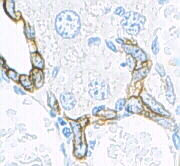The building blocks of hair, are protein. The specific protein that hair is made of, is called keratin, or specifically Alpha-keratin. The keratin, in turn, is made up of smaller building blocks called amino acids. There are a few different types of amino acids in keratin, such as leucine and arginine. I'm not going to go any further into the different types of amino acids.
As you can see in the first figure above, alpha-keratin looks like a helix. Two of these helices, as you can see in the second figure, twist together into a dimer. So, to clarify, a dimer is two keratin helixes twisted together. In a dimer, amino acids bond these helices together in disulfide bonds. The dimers, in turn, bond with other dimers both vertically and horizontally, also through disulfide bonds. And this is the very basic explanation of how hair is structured.
Treating damaged hair
Disulfide bonds can be broken through various things - wear and tear, bleach, heat styling, among others. The hair will feel dry, and brittle, and possibly break off easily. Until recently, no one had claimed that these bonds can be repaired. Then Olaplex was launched on the market. I'll go into hair bond repairants like Olaplex in a future post, but for now, it's fairly safe to say that for all that Olaplex claims to do, there are far more PR and marketing than actual research backing up Olaplex and similar products.
The more commonly used products to treat damaged hair, are products that coat the hair, such as silicone. They temporarily "glue" the hair together. After a few days, the products wear off, or you wash them out. So called protein products are another option. These products deposit protein in the cracks in the hair. Typically, this product sticks around a little longer, but it's still temporary since the added protein doesn't bond to the hair's natural protein.
Maintaining your protein
If simply masking the damaged hair isn't enough for you, your best bet is to cut off any damaged hair and start protecting your healthy hair from damage. Healthy hair will have some - but relatively little - broken disulfide bonds. So even healthy hair can do with some added protein. How much, is very individual. If your hair starts feeling stiff, rough, and brittle, you may be overdoing it. In that case you should add more moisture! I wrote a bit about moisture-protein balance in Lesson 2: Moisturisers and Sealants.
Aside from minimising damaging treatments such as hair dyeing and heat styling, you can start using penetrative oils. I also wrote a bit about that in Lesson 2. Penetrative oils penetrate the hair shaft and protects the disulfide bonds from breaking. Hair washing will break some bonds, and coating your hair in oil before will actually help protect it. If you know bleaching is damaging, but you still want to do it, pre-treating the hair with oil can help minimising damage. Coconut oil is the only oil so far (to my knowledge) that is scientifically proven to protect against bond breakage. The scientists thought this is because coconut oil has small, straight, molecules that can penetrate the hair shaft easily, and is also high in the fatty acid "lauric acid" which can form bonds with the amino acids in keratin. That's how coconut oil protects the hair's disulfide bonds. Palm oil is another oil that has small, straight molecules and a high content of lauric acid. In theory, palm oil should also protect against hair damage, but it hasn't been scientifically tested yet. Olive oil and avocado oil are two other popular oils that can penetrate the hair shaft due to relatively straight and small molecules, but both are high in oleic acid rather than lauric acid. I haven't found any science regarding whether oleic acid can bond with and protect keratin, but in my anecdotal experience, olive oil will leave my hair feeling nice if I pre-treat it with olive oil before washing. Over on NaturallyCurly they do indicate that oils like olive and avocado do attach to the hair proteins, but I don't know what source they have on that, so I don't trust it completely.
Even if penetrative oil without lauric acid don't protect the bonds in hair by bonding with them, they can protect against breakage. Some of the oil won't absorb into the hair shaft, but form a protective film on the surface. Like substances that dot not penetrate the hair shaft, such as non-penetrative oils or silicones, they will protect against breakage since they provide slip. Less tangling and easier detangling will minimise hair breakage.


No comments:
Post a Comment